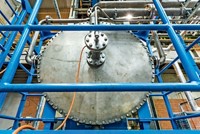Advertisement
Grab your lab coat. Let's get started
Welcome!
Welcome!
Create an account below to get 6 C&EN articles per month, receive newsletters and more - all free.
It seems this is your first time logging in online. Please enter the following information to continue.
As an ACS member you automatically get access to this site. All we need is few more details to create your reading experience.
Not you? Sign in with a different account.
Not you? Sign in with a different account.
ERROR 1
ERROR 1
ERROR 2
ERROR 2
ERROR 2
ERROR 2
ERROR 2
Password and Confirm password must match.
If you have an ACS member number, please enter it here so we can link this account to your membership. (optional)
ERROR 2
ACS values your privacy. By submitting your information, you are gaining access to C&EN and subscribing to our weekly newsletter. We use the information you provide to make your reading experience better, and we will never sell your data to third party members.
Business
Hydrogen Power
GE and BP team up on projects to produce H2 from fossil fuels while sequestering CO2
by Marc S. Reisch
July 24, 2006
| A version of this story appeared in
Volume 84, Issue 30
Two iconic firms have teamed up to develop and deploy as many as 15 commercial hydrogen power projects over the next decade.
The oil giant BP and electricity-generation equipment maker GE have already begun work on two projects. Both will convert fossil fuels into hydrogen that will be burned to generate electric power from turbines. The companies will capture and sequester 90% of the carbon dioxide created in the process and then inject it into deep geological formations.
The projects will demonstrate that hydrogen is "efficient, reliable, and economical for large-scale commercial power production," says David L. Calhoun, CEO of GE Infrastructure. "Our financial strength will ensure it happens now globally, changing the way we envision our energy future."
In Peterhead, Scotland, the firms are cooperating on a 475-MW hydrogen-fired power plant based on natural gas that should begin operating in 2010. They plan to sequester 1.8 million metric tons of CO2 per year 4,000 feet below the seabed in the nearby Miller oil field. The CO2 will enable the production of 40 million barrels of oil that otherwise might not have been recoverable, the firms say.
In Carson, Calif., petroleum coke, a refinery by-product, will serve as the hydrogen source for a 500-MW power-generating project due in 2011. The partners will capture and sequester 4 million metric tons of CO2 per year, which will also be used to enhance oil production.
In March, Shell and Statoil announced the world's first project to capture CO2 generated at a gas-fired power plant for use in enhancing offshore oil production (C&EN, March 20, page 9). However, that project does not have the hydrogen component that the GE and BP projects do.



Join the conversation
Contact the reporter
Submit a Letter to the Editor for publication
Engage with us on Twitter